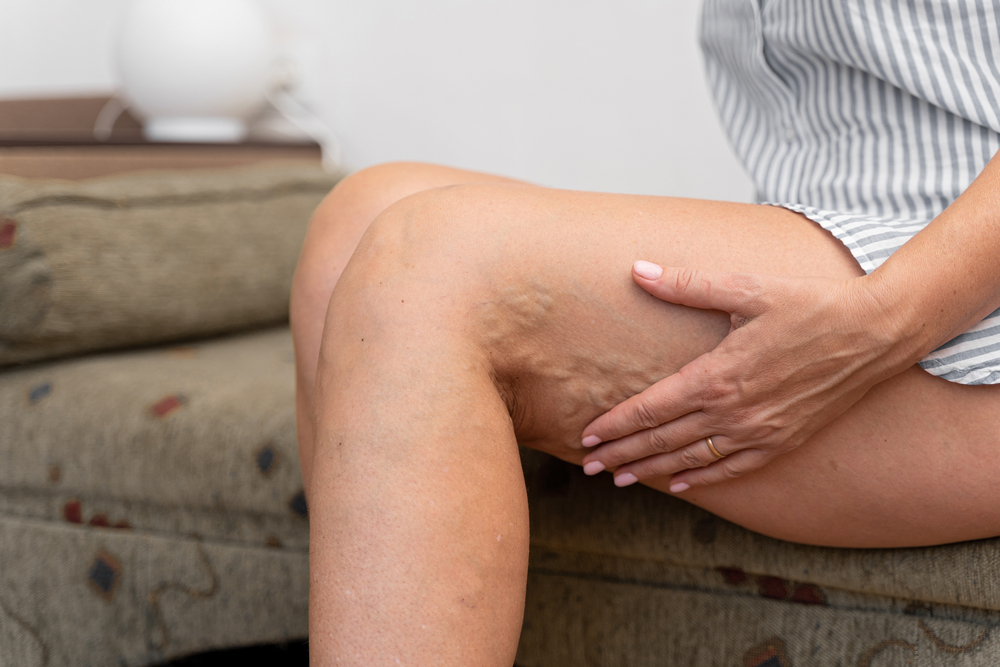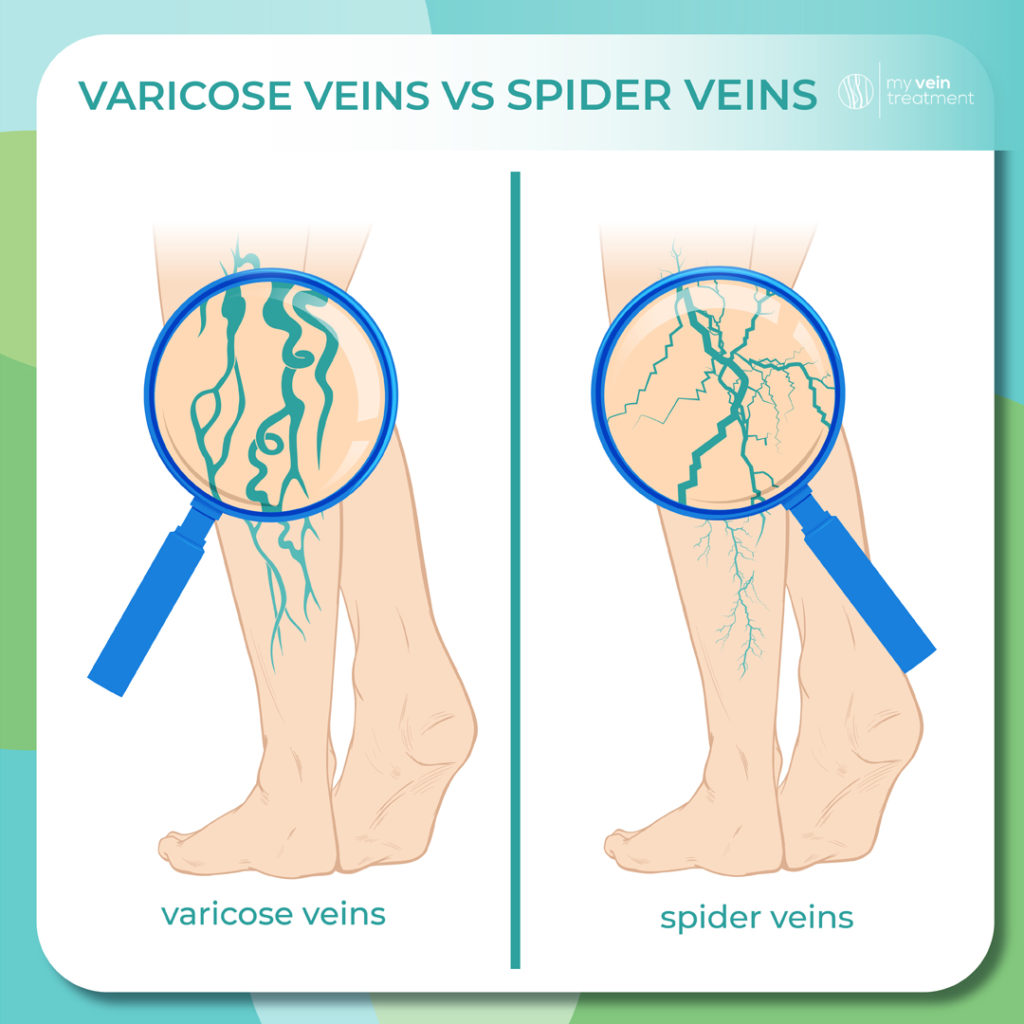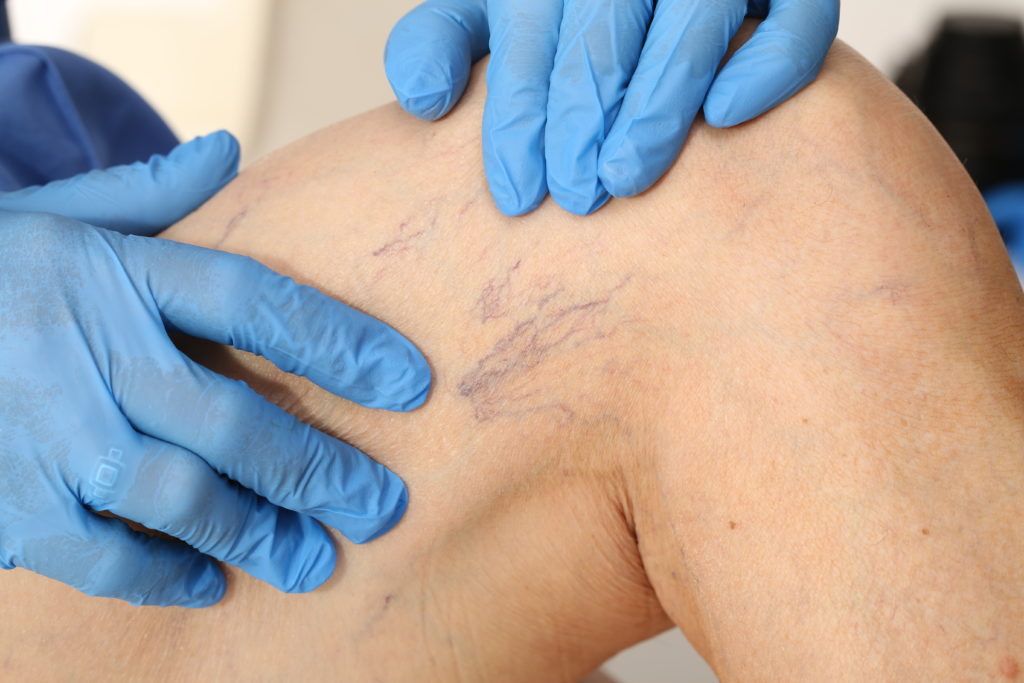Varicose veins and spider veins are both very common, affecting millions of Americans. But what are varicose veins? What are spider veins? Both conditions are caused…
Varicose Veins vs. Spider Veins: What’s the Difference?

Varicose veins and spider veins are both very common, affecting millions of Americans. But what are varicose veins? What are spider veins? Both conditions are caused by blood collecting in a vein, making it swell and darken — but they have different symptoms, complications, and treatment options.
Appearance
Size is the most significant difference between varicose veins and spider veins. They also differ in how they feel to the touch and the patterns they tend to form.
What Do Varicose Veins Look Like?
Gnarled and bumpy, varicose veins bulge outward and have a rope-like appearance. They are often blue or purple but can also appear greenish or match the color of the skin. To be diagnosed as varicose veins, they must measure at least 3 millimeters in diameter. While sometimes only an inch long, varicose veins can extend longer.
What Do Spider Veins Look Like?
A spider vein will almost always be described as “small”, and for a good reason. They are thread-like red or blue lines less than 1 millimeter in diameter. They can be as short as a half-inch and are seldom longer than several inches. Spider veins tend to appear in clusters that resemble tree branches or spider webs. They can look red, blue, or dark purple. Unlike varicose veins, they do not cause the skin to bulge.

Risk Factors
Varicose veins and spider veins are not always preventable, but lifestyle changes can help reduce your chances of developing them. Both have the same set of risk factors.
Female Hormones
High levels of estrogen and progesterone make women, especially pregnant women, prone to varicose veins and spider veins. These female hormones tend to relax and thin the walls of blood vessels, making the valves more likely to leak. For this reason, hormonal birth control and menopausal hormone therapy increase your risk of varicose veins and spider veins.
Pregnancy
During pregnancy, your blood volume increases dramatically, causing your veins to swell. The extra weight you carry during pregnancy also puts pressure on your blood vessels. If varicose veins pop up during pregnancy, they may go away on their own a few months after the baby is born, or they may remain long term.
Age
As women near menopause, the levels of estrogen and progesterone rise and drop sharply, causing the walls of blood vessels to thicken and become less flexible. As you get older, the valves in your veins stop working as well and your calf muscles tend to get weaker. The calf muscles squeeze the veins in your legs as you walk, helping to send blood back to the heart.
Family History
If a close family member has varicose veins or spider veins, you are more likely to get them. If you have a personal history of varicose veins, you are at a higher risk than someone who has never experienced them.
Lifestyle
Extra weight puts extra pressure on the walls and valves of your blood vessels, so maintaining a healthy body weight can decrease the chances of developing varicose veins and spider veins.
Sitting or standing for long periods is a risk factor. Brief breaks to move around during the day can relieve pressure and give your muscles a chance to help the veins.
Smoking increases both the risk of getting varicose veins and the risk of complications like ulcers.

Symptoms
Varicose veins are sometimes painless but often cause uncomfortable symptoms in the legs. Spider veins hardly ever cause symptoms other than their undesirable appearance on the skin.
Varicose vein symptoms:
- Aching, cramping, burning, throbbing, or tingling
- The sensation of heaviness in the legs
- Swelling in the leg, ankle, or foot
Spider vein symptoms:
- Most spider veins are not painful, but some people experience a mild burning sensation or dull discomfort at the site.
Possible Further Complications
Varicose veins do not usually lead to complications, but if left untreated, they can eventually result in skin problems or infections. Spider veins, on the other hand, are harmless and do not cause any of the following complications:
Bleeding
If you cut or bump your leg, varicose veins can bleed more than you would expect. This bleeding can be difficult to stop at home and may require medical treatment.
Varicose Eczema
The skin over varicose veins can become itchy, dry, and discolored. Without treatment, this form of eczema can eventually lead to permanent thickening, darkening, or hardening of the skin.
Venous Ulcers
Left untreated for years, varicose veins can cause ulcers – open sores on the skin that can be hard to heal.
Symptoms include oozing, bleeding, swelling, itching, or burning. Proper medical treatment is essential to prevent infection from developing. Even after treatment, these ulcers can leave scarring on the legs.
Blood Clots
Rarely, an untreated varicose vein may be blocked by a superficial, non-life-threatening blood clot, leading to redness, swelling, and pain in the affected leg.
Popular Treatments
Varicose veins do not always require intervention, but treatment may be medically necessary if they cause significant pain or complications. Spider vein treatments are almost always elective procedures chosen to eliminate the blemishes.
Varicose Vein Treatments
In mild or moderate cases, your doctor may encourage you to try home treatments such as elevating your legs or wearing compression stockings. They may suggest avoiding long periods of sitting or standing if possible, or they might advise bending and flexing the legs often if you cannot take breaks to move around.
If home treatments do not help or if varicose veins lead to complications, your vein specialist may recommend a procedure to seal and close the vein. Thermal ablation (EVLA) uses heat, radiofrequency ablation (ClosureFast or Venclose) uses radio waves, and cyanoacrylate ablation (VenaSeal) uses a surgical-grade adhesive to seal the vein. Foam sclerotherapy (Varithena) uses injections of a solution that causes the problem vein to close off.
Spider Vein Treatments
The same home treatments and lifestyle changes are often prescribed. As spider veins rarely cause symptoms and do not lead to complications, any further treatment is considered cosmetic. Sclerotherapy and laser treatments are common options for spider veins. Microwave technology (Veinwave/VeinGogh/ThermaVein) is used to treat the smallest spider veins, often found on the face or ankles.
Finding a Vein Specialist
If you would like to discuss your treatment options, a vein specialist can diagnose varicose veins or spider veins, answer your questions, and provide individualized treatment and follow-up.
Search for a specialist near you with My Vein Treatment’s comprehensive vein specialist locator tool.






Responses